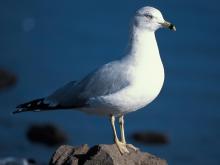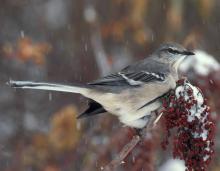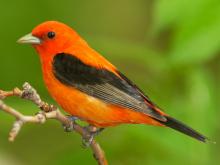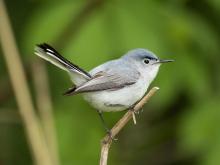Birds
Media

Species Types
Scientific Name
Branta canadensis
Description
Canada geese are recognizable by their brownish bodies, black necks and heads, and a distinctive broad white patch that runs beneath their heads from ear to ear.
Media

Species Types
Scientific Name
Larus delawarensis
Description
The ring-billed gull is Missouri’s most common gull. Adults can be told from our other most common gulls by their yellow legs and yellow bill with a black ring near the tip.
Media

Species Types
Scientific Name
Chen caerulescens
Description
The snow goose has two color forms: white and blue. The “blue goose” was once considered a separate species. Both share the distinctive feature of a black “lipstick” streak along the edge of the bill.
Media

Species Types
Scientific Name
Mimus polyglottos
Description
One of the best-known U.S. songbirds, the northern mockingbird can sing endlessly, night and day, repeating phrases from the songs of other birds. Its white wing patches are conspicuous in flight.
Media

Species Types
Scientific Name
Piranga olivacea
Description
In summer, scarlet tanagers feed on insects and fruit in the canopy of oak-hickory forests and in large shade trees of the eastern U.S. and southern Canada.
Media

Species Types
Scientific Name
Piranga rubra
Description
Adult male summer tanagers are entirely red — an unforgettable sight as they forage for insects among bright green tree leaves in early summer.
Media

Species Types
Scientific Name
Stelgidopteryx serripennis
Description
Northern rough-winged swallows are sleek, agile fliers with brown upperparts, brownish-white throat, and whitish underparts. They are common summer residents in Missouri. People most often see them chasing flying insects over land or water.
Media

Species Types
Scientific Name
Ictinia mississippiensis
Description
The Mississippi kite is a rare summer resident in Missouri, usually seen flying above forests and grasslands along the Mississippi River valley. The flight of this rather small raptor is buoyant, like that of a swallow, or, yes, a kite.
Media

Species Types
Scientific Name
Polioptila caerulea
Description
Male blue-gray gnatcatchers are bluish gray and females are gray. The underparts are pale gray. The tail is black with white outer feathers, so when folded it appears white from below. There is a white eye ring. Common summer residents in Missouri, they habitually jerk their tails from side to side.
Media

Species Types
Scientific Name
Corthylio calendula
Description
Kinglets are very small, active, insect-eating birds that Missourians see in winter and during migration in spring and fall. Ruby-crowned kinglets are grayish olive, have white wing bars, and flick their wings as they flit around. Males have a small red crown that they occasionally raise.
See Also







Media

Species Types
Scientific Name
Hemaris diffinis
Description
The snowberry clearwing is a moth that confuses people because it looks like a bumblebee and flies like a hummingbird!
Media

Species Types
Scientific Name
Hyles lineata
Description
The white-lined sphinx moth sometimes confuses people because it flies, hovers, and eats from flowers like a hummingbird. The adults often fly during daylight hours as well as in the night and are often found at lights.
Media

Species Types
Scientific Name
Darapsa myron
Description
The Virginia creeper sphinx moth is common in woods and brushy areas and comes to lights at night. The larvae eat Virginia creeper and grape leaves.
Media

Species Types
Scientific Name
Perimyotis subflavus (formerly Pipistrellus subflavus)
Description
Tri-colored bats, formerly called eastern pipistrelles, are relatively small and look pale yellowish or pale reddish brown. The main hairs are dark gray at the base, broadly banded with yellowish brown, and tipped with dark brown.
Media

Species Types
Scientific Name
Myotis grisescens
Description
Gray myotises are difficult to distinguish from other mouse-eared bats. A key identifying feature of the gray myotis is that its wing is attached to the ankle and not at the base of the toes. It’s an endangered species.
Media

Species Types
Scientific Name
Myotis lucifugus
Description
The little brown myotis (little brown bat) is one of our most common bats, but populations are declining. White-nose syndrome has taken a heavy toll in northeastern states. This species is now listed as vulnerable across its range.
Media

Species Types
Scientific Name
Myotis sodalis
Description
The Indiana myotis, or Indiana bat, summers along streams and rivers in north Missouri, raising its young under the bark of certain trees. It is an endangered species.
About Birds in Missouri
About 350 species of birds are likely to be seen in Missouri, though nearly 400 have been recorded within our borders. Most people know a bird when they see one — it has feathers, wings, and a bill. Birds are warm-blooded, and most species can fly. Many migrate hundreds or thousands of miles. Birds lay hard-shelled eggs (often in a nest), and the parents care for the young. Many communicate with songs and calls.





















